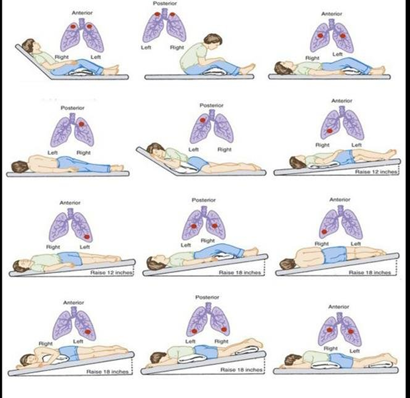2.2 Lab Activities
2.2 Lab Activity
In the laboratory classroom, you and a partner will place each other in the postural drainage positions as illustrated in Figure 7[1] below and will practice manual percussion and vibration.

1. On a separate piece of paper, list the indications and contraindications for chest physiotherapy (CPT).
2. With your laboratory partner, obtain the positive expiratory pressure (PEP) devices, practice and explain the operation of the devices used in your lab.
3. On a separate piece of paper, list the indications and contraindications for PEP.
4. With your laboratory partner, obtain the high-frequency chest wall oscillation (HFCWO) device and practice and explain the operation of the device. Place the device on each other and manipulate the hertz and pressure by pressing the up and down button located on the front of the device.
5. List the indications and contraindications for HFCWO on a separate piece of paper.
6. Teach your laboratory partner how to huff cough.
7. View the following supplementary YouTube videos[2],[3] on active cycle of breathing and autogenic drainage:
- “Postural Drainage Positions” is used on the basis of Fair Use. Access for free at https://www.researchgate.net/figure/Postural-Drainage-Positions_fig1_348620409 ↵
- NHS University Hospitals Plymouth Physiotherapy. (2015, May 12). Active cycle of breathing technique (ACBT) [Video]. YouTube. All rights reserved. https://www.youtube.com/watch?v=XvorhwGZGm8&t=26s ↵
- NHS University Hospitals Plymouth Physiotherapy. (2015, May 12). Autogenic drainage [Video]. YouTube. All rights reserved. https://www.youtube.com/watch?v=_n0nuy8VWmI ↵

